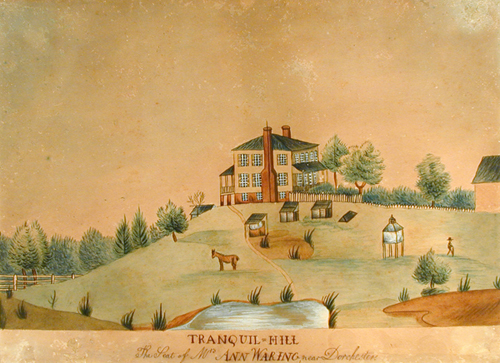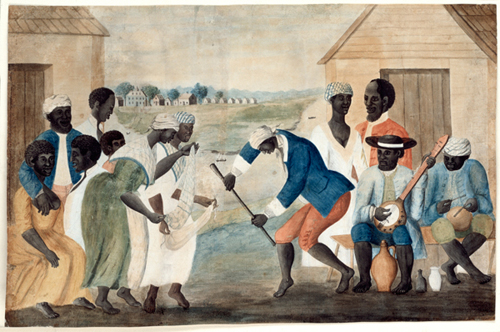
Last month I had the pleasure of visiting Colonial Williamsburg to oversee the installation of the Gibbes watercolor Tranquil Hill which is on loan to the Abby Aldrich Rockefeller Folk Art Museum for the next two years. This painting depicts an early nineteenth-century plantation landscape and has been in the Gibbes collection since 1972. Though the general location of the scene is clearly inscribed at the bottom of the painting, “Tranquil-Hill The Seat of Ann Waring, Near Dorchester,” the artist who painted it remains a mystery…or does it?
Recent research has linked our Tranquil Hill to the famous painting known as The Old Plantation, an image that has long been considered the best known depiction of early American slave life and culture in existence. The Old Plantation has perplexed art historians for generations. Who painted it, when was it made, where are the subjects, and what are they doing, were all unanswered questions. But over the last decade, Dr. Susan Shames, decorative arts librarian at Colonial Williamsburg Foundation, has worked diligently to unravel these unsolved mysteries. In her recent book The Old Plantation: The Artist Revealed, Shames brings to light the evidence that led her to solve one of the great art mysteries of modern day.
Shames’ intensive research has definitively identified the artist of The Old Plantation as John Rose (1752/53-1820), a South Carolina planter, and suggests that the image was likely painted on his plantation near Beaufort around 1785–1790. The fascinating detective work that led Shames to this conclusion and much more about the painting is successfully presented in her book as well as in the recently opened exhibition. In both, Shames also examines the Gibbes’ mysterious painting Tranquil Hill and posits that it too may be a work by the hand of John Rose.
The evidence is still inconclusive on this last matter, as the two images are stylistically quite different, but Shames’ research uncovered several important facts about Tranquil Hill that connect it to John Rose. Rose and his family moved from Beaufort to Dorchester in 1795. There, he and Ann Ball Waring attended the same small church, lived in close proximity, and clearly traveled in the same social circles. The watermark on the paper suggests that the painting was likely made after 1805 during the time Rose lived in Dorchester. This information supports Shames’ theory that Rose, who painted as a hobby, made it as a gift for his friend and neighbor Ann Waring. This new hypothesis certainly inspires further investigation into this painting.
If you like a good art detective story, check out the The Old Plantation: The Artist Revealed by Susan Shames. Tranquil Hill will be on view with The Old Plantation and one other work by John Rose at the Abby Aldrich Rockefeller Folk Art Museum through 2012.
—Sara Arnold, curator of collections, Gibbes Museum of Art
Published March 17, 2011


